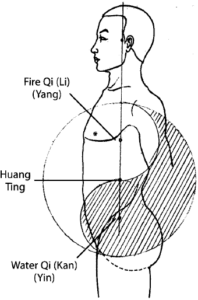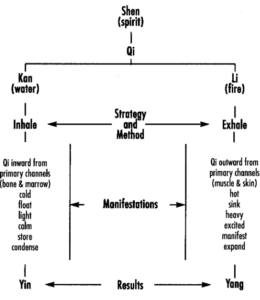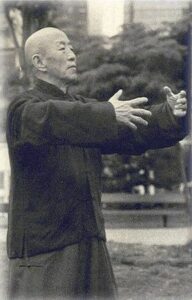Théorie du Yin-Yang et de Kan-Li
To practice Qigong accurately, you must not only understand the theory but also the correct methods of practice. Knowing the theory correctly places a clear and accurate map in your hands, leading you to your goal in the shortest time. Without this map, you may take many years to fìnd the correct path.Two of the most important concepts in Qigong practice are the theory of Yin and Yang, and of Kan and Li. These two concepts have been commonly confused in Qigong society even in China.If you are able to understand them clearly, you will have grasped an important key to the practice of Qigong.
What are Kan and Li ?
Kan and Li training has long been of major importance to Qigong practitioners. In order to understand why, you must understand these two words, and the theory behind them. The terms Kan (坎) and Li (雄) occur frequently in Qigong documents. In the Eight Trigrams Kan represents « Water » while Li represents « Fire ». However, the everyday terms water and fìre are also often used. First you should understand that though Kan-Li and Yin-Yang are related, Kan and Li are NOT Yin and Yang. Kan is Water, which is able to cool your body down and make it more Yin, while Li is Fire, which warms your body and makes it more Yang. Kan and Li are the methods or causes , while Yin and Yang are the results. When Kan and Li are adjusted or regulated correctly, Yin and Yang will be balanced and interact harmoniously. Many Qigong practitioners believe that your body is always too Yang, unless you are sick or have not eaten for a long time, in which case your body may be more Yin.  When your body is always Yang, it is degenerating and burning out. It is believed that this is the cause of aging. If you are able to use Water to cool down your body, you can slow down the process of degeneration, and thereby lengthen your life. This is the main reason why Qigong practitioners have been studying ways of improving the quality of Water in their bodies, and of reducing the quantity of Fire. I believe that, as a Qigong practitioner, you should always keep this subject at the top of your list for study and research. If you earnestly ponder and experiment, you can grasp the trick of adjusting them. If you want to learn how to adjust them, you must understand that Water and Fire mean many things in your body.
When your body is always Yang, it is degenerating and burning out. It is believed that this is the cause of aging. If you are able to use Water to cool down your body, you can slow down the process of degeneration, and thereby lengthen your life. This is the main reason why Qigong practitioners have been studying ways of improving the quality of Water in their bodies, and of reducing the quantity of Fire. I believe that, as a Qigong practitioner, you should always keep this subject at the top of your list for study and research. If you earnestly ponder and experiment, you can grasp the trick of adjusting them. If you want to learn how to adjust them, you must understand that Water and Fire mean many things in your body.
The fìrst concern is your Qi. Qi is classified as Fire or Water. When your Qi is not pure, and causes your physical body to heat up and your mental/spiritual body to become unstable (Yang), it is classifìed as Fire Qi. The Qi which is pure and is able to cool both your physical and spiritual bodies (make them more Yin) is considered Water Qi. However, your body can never be purely Water. Water can cool down the Fire, but it must never totally quench it, because then you would be dead. It is also said that Fire Qi is able to agitate and stimulate the emotions, and from these emotions generate a « mind ». This mind is called Xin, and is considered the Fire mind, Yang mind, or emotional mind. On the other hand, the mind that Water Qi generates is calm, steady, and wise. This mind is called Yi, and is considered to be the Water mind or wisdom mind. If your Shen is nourished by Fire Qi, although your Shen may be high, it will be scattered and confused (a Yang Shen). Naturally, if the Shen is nourished and raised up by Water Qi, it will be fìrm and steady (a Yin mind).
When your Yi is able to govern your emotional Xin effectively, your will (strong emotional intention) can be fìrm.
You can see from this discussion that your Qi is the main cause of the Yin and Yang of your physical body, your mind, and your Shen. To regulate your body’s Yin and Yang, you must learn how to regulate your body’s Water and Fire Qi, and to do this effìciently you must know their sources. In order to understand Kan and Li clearly and to adjust them effìciently, you are urged to use the modern scientific medical point of view to analyze these concepts. This will allow you to marry the past and present and give birth to the future.
Kan and Li in Breathing, Mind, and Shen
Here we introduce the general concepts of how Kan and Li relate to your breathing, mind, and Shen. Then, we will combine them together and construct a secret key which willlead you to the Qigong treasure. Breathing’s Kan and Li. In Qigong, breathing is considered a « strategy » which enables you to lead the Qi effectively. For example, you can use your breath to lead the Qi to your skin or marrow. Slow or fast breathing can make the flow of Qi calm or vigorous. When you are excited your body is Yang , and you exhale more than you inhale. This leads the Qi to the skin so that you sweat, and the excess dissipates in the surrounding air. When you are sad your body is Yin, and you inhale more than you exhale to lead the Qi inward to conserve it, and you feel cold. You can see that breathing can be the main cause of changing the body’s Yin and Yang. Therefore, breathing has Kan and Li. Generally speaking, in the normal state of your body, inhaling is considered to be a Water activity (Kan) because you lead the Qi inward to the bone marrow where it is stored. This reduces the Qi in the muscles and tendons, which calms down the body’s Yang. Exhaling is considered a Fire activity (Li) because it brings Qi outward to the muscles, tendons, and skin to energize them, making the body more Yang.
Remember when the body is more Yang than its surroundings, the Qi in the body is automatically dissipated outward.
Normally, Yin and Yang should be balanced so that your body will function harmoniously.
The trick to maintaining this balance is using breathing strategy. Usually your inhalations and exhalations should be equal. However, when you are excited your body is too Yang , so you may inhale longer and deeper to calm down your mind and lead the Qi inside your body to make it more Yin. In Qigong practice, it is very important to grasp the trick of correct breathing. It is the exhalation which leads Qi to the fìve centers (head, two Laogong cavities at the center of the palms , and two Yongquan cavities near the center of the soles), and the skin to exchange Qi with the surroundings. Inhalation leads Qi deep inside your body to reach the internal organs and marrow. Clic on graphic which summarizes how different breathing strategies affect the body’s Yin and Yang in their various manifestations.
In Qigong practice, it is very important to grasp the trick of correct breathing. It is the exhalation which leads Qi to the fìve centers (head, two Laogong cavities at the center of the palms , and two Yongquan cavities near the center of the soles), and the skin to exchange Qi with the surroundings. Inhalation leads Qi deep inside your body to reach the internal organs and marrow. Clic on graphic which summarizes how different breathing strategies affect the body’s Yin and Yang in their various manifestations.
The Mind’s Kan and Li.
According to Chinese tradition, a human has two minds: Xin (心) and Yi (意). Xin is translated literally as « heart » and is considered as the mind generated from emotional disturbance. Therefore, Xin can be translated as « Emotional Mind. » The Chinese word for Yi is constructed of three characters. The top one means « establish » (立) the middle one means « speaking » (曰) and the bottom one is « heart » (心) That means the emotional mind is under control when you speak. Therefore , Yi can be translated as « Wisdom Mind » or « Rational Mind. » Because the Emotional Mind makes you excited and emotionally disturbed, which results in the excitement of your body (Yang), it is considered as Li. The Wisdom Mind which makes you calm, peaceful, and able to think clearly (Yin) is considered to be Kan.
In Qigong training, the mind is considered the « general » who directs the entire battle. It is the general who decides the fìghting strategy (breathing) and controls the movement of the soldiers (Qi} Therefore, as a general, you must control your Xin (Emotional Mind) and use your Yi (Wisdom Mind) to evaluate and understand the situation, and then fìnally decide on the proper strategy.
In Qigong, your wisdom mind must first dominate the situation and generate an idea. This idea generates and executes the strategy (breathing) and is also the force that moves the Qi. Generally speaking, when your mind is excited, aggressive, and energized, the strategy (breathing) is more offensive (emphasizing exhalation) and the Qi circulation is more vigorous and expansive. This aggressive mind is then considered a Fire mind, since it is able to make your body more Yang. However, when the strategy is more defensive (i.e. emphasizing inhalation), the Qi circulation will be more calm and condensing. Therefore, a calm or depressed mind is considered a Water mind, since it can make your body more Yin. You can notice that the Kan and Li of the mind are more important than those of breathing. After all, it is the mind which makes the strategy. Regulating the mind and the breathing are two of the basic techniques for controlling your body’s Yin and Yang. Regulating the mind and the breathing cannot be separated. When the mind is regulated, the breathing can be regulated. When the breathing is regulated, the mind is able to enter a deeper level of calmness.
The Shen’s Kan and Li.
Now it is time to consider the fìnal and most decisive element in winning a battle: the Shen (神). Shen is compared to the morale of the general’s, officers and soldiers. There are many cases throughout history of armies winning battles against great odds because the morale of their soldiers was high. If a soldier’s morale is high enough, he can defeat ten enemies. It is the same in Qigong training. It is the Shen which determines how successful your Qigong practice will be. Your Yi (Wisdom Mind), which is the general who makes the strategy, must also be concerned with raising up the fighting morale (Shen) of the soldiers (Qi). When their morale is raised the soldiers can be led more effìciently, and consequently the strategy can be executed more effectively.
You can see that knowing how to use the Yi to raise the Shen is the major key to successful Qigong training. In Qigong, Shen is considered the headquarters which governs the Qi. As a matter of fact, both Yi and Shen govern the Qi. They are closely related and cannot be separated. Generally speaking , when the wisdom mind (Yi) is energized, the Shen is also raised. You should understand that in Qigong training, you want to raise up your Shen but not let it get excited. When the Shen is raised, the strategy can be carried out effectively. However, if the Shen is excited, the body will become too Yang , and that is not desirable in Qigong practice. When you are practicing Qigong, you want to keep your Shen high all the time and use it to govern the strategy and the Qi. This will enable you to re-adjust or regulate your Kan and Li effìciently. Shen is the control tower which is able to adjust the Kan and Li, but it does not have Kan and Li itself. However, some Qigong practitioners consider the raised Shen to be Li (Fire) and the calm Shen to be Kan (Water).
Now, let us draw a few important conclusions from the above discussion:
A. Kan (Water) and Li (Fire) are not Yin and Yang. Kan and Li are methods which can cause Yin or Yang
B. Qi itself is only a form of energy and does not have Kan and Li. When Qi is too excessive or too defìcient, it can cause the body to be too Yang or too Yin
C. When you adjust Kan and Li in the body, the mind is the first concern. The mind can be Kan or Li. It determines the strategy (breathing) for withdrawing the Qi (Kan) or expanding it (Li)
D. Breathing has Kan and Li. Usually inhaling, which makes the body more Yin, is Kan. Exhaling, which makes the body more Yang, is Li
E. The Shen does not have Kan and Li. Shen is the key to making the Kan and Li adjustment effective and effìcient
The Key Secrets of Adjusting Kan and Li
In the light of these conclusions, let us discuss the keys of Kan and Li adjustment. These keys are repeatedly mentioned in the ancient documents. The fìrst key is that Shen and Breathing mutually rely on each other. The second key is that Shen and Qi mutually combine and harmonize with each other.
Shen and Breathing Mutually Dependent (Shen xi Xiang Yi , 神息相依).
We know that breathing is the strategy which directs the Qi in various ways and therefore controls and adjusts the Kan and Li, which in turn control the body’s Yin and Yang. We also know that the Shen is the control tower which is able to make the strategy work in the most effìcient way. Therefore, Shen governs the strategy directly, and controls Kan and Li and the body’s Yin and Yang indirectly. You can see that the success of your Kan and Li adjustment depends upon your Shen. When the Shen matches your inhaling and exhaling, it can lead the Qi to condense and expand directly in the most effìcient way.
Your Shen must match with the breathing to be raised up or calmed down, and the breathing must rely on the Shen to make the strategy work effìciently. In this case, it seems that the Shen and breathing are depending on each other and cannot be separated. In Qigong practice, this training is called « Shen xi Xi ang Yi » (神息相依) which means « Shen and breathing depend on each other. » When your Shen and breathing are matching each other, it is called « Shen Xi » (神息) (i. e. Shen breathing) because it seems that your Shen is actually doing the breathing.
You can see that « Shen xi Xiang Yi » is a technique or method in which, when the Shen and breathing are united together, the Shen is able to control the Qi more directly.
Shen and Qi Mutually Combined (Shen Qi Xiang He ,神轧相合).
When your Shen and breathing are able to match with each other as one, then the Qi can be led directly, and thus Shen and Qi become one. In Qigong practice it is called « Shen Qi Xiang He » (神氛相合) which means « Shen and Qi mutually combined and harmonized« . When this happens, the Shen can govern the Qi directly and more efficiently.
You can see from this that the Shen and Qi combining is the result of the Shen and breathing being mutually dependent. Grand Master DaMo (连磨) believed that in order to have a long and peaceful life, Shen and Qi must be coordinated and harmonized with each other. He said: « If (one) does not know how to keep the mother (Qi) and son (Shen) together, though the Qi (is directed) by breathing internally (nevertheless) the Shen is labored and craves external (objects), resulting in the Shen being always debauched and dirty; the Shen is thus not clear. (If) the Shen is not clear, the original harmonious Qi will disperse gradually, (Shen and Qi) cannot be kept together ».
From this , you can see that Shen is very important. To regulate the Shen is one of the highest levels of Qigong practice. The reason for this is simply that in order to reach a high level of harmony, you must first regulate your emotional mind ! This can be hard to achieve in laymen society…
Courtesy Dr. Yang, Jwing-Ming – Qigong Meditation, Embryonic Breathing (text extracts)
YMAA Publication Center
Boston, Mass. USA

